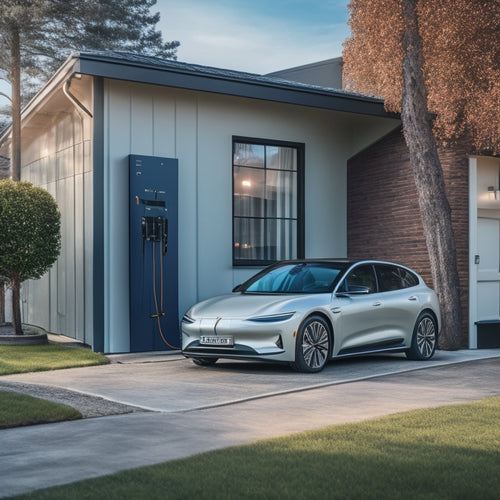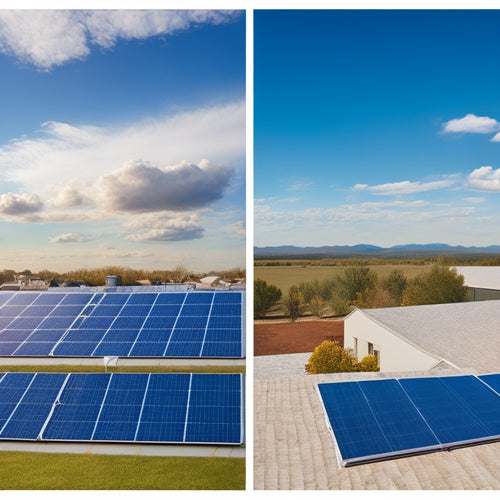
Slash Energy Costs With Commercial Solar Power
Share
By installing commercial solar power, you can reduce your energy bills by up to 50% and optimize energy consumption, decreasing your reliance on traditional energy sources and minimizing your carbon footprint. Conducting energy audits helps pinpoint areas of inefficiency, and solar power generates clean energy on-site, reducing waste and greenhouse gas emissions. With government incentives and rebates, the upfront costs of installation are minimized. Now, you're one step closer to realizing significant energy savings and a more sustainable future - and there's more to explore on how to make that happen.
Key Takeaways
• Commercial solar power can reduce energy bills by up to 50% for businesses with high energy demands.
• Conducting energy audits helps identify areas of inefficiency and optimizes energy consumption, leading to substantial cost savings.
• Solar power generates clean energy on-site, decreasing greenhouse gas emissions and reliance on traditional energy sources.
• Government incentives and rebates, such as the 30% federal tax credit, reduce the upfront costs of commercial solar power installations.
• A well-designed and properly maintained commercial solar panel system can last for 25 years or more, providing long-term energy savings.
Unlocking Energy Savings Potential
By investing in commercial solar power, you can tap into significant energy savings potential, reducing your reliance on the grid and slashing your energy bills by up to 50%. This is especially true for businesses with high energy demands, such as manufacturing facilities, data centers, and large office buildings.
To access this potential, consider conducting an energy audit to identify areas of inefficiency in your current energy usage. This thorough assessment will help you pinpoint opportunities to optimize your energy consumption and reduce waste. By doing so, you'll not only lower your energy bills but also shrink your carbon footprint.
Commercial solar power allows you to generate clean energy on-site, reducing your reliance on fossil fuels and decreasing greenhouse gas emissions. By harnessing the power of the sun, you can noticeably decrease your carbon footprint, contributing to a more sustainable future.
With energy audits and commercial solar power, you can take the first step towards a more environmentally friendly and cost-effective energy strategy.
Cutting Energy Bills With Solar
As a commercial property owner, you're likely always looking for ways to reduce energy expenditure and lower utility bills.
By installing a solar power system, you can substantially cut your energy costs and redirect those savings to more critical areas of your business.
With solar energy, you'll be generating your own clean power, reducing your reliance on the grid, and enjoying lower energy bills as a result.
Reduce Energy Expenditure
Your energy expenditure can substantially decrease when you harness commercial solar power, allowing you to allocate resources more efficiently.
By integrating solar energy into your operations, you'll dramatically reduce your reliance on traditional energy sources. This, in turn, will lead to substantial cost savings.
To maximize these savings, you must identify areas of inefficiency in your current energy usage.
Conducting energy audits can help you pinpoint these areas, allowing you to optimize your energy consumption.
Lower Utility Bills
With commercial solar power, you can substantially cut your energy bills by generating free, clean electricity on-site, reducing your reliance on the grid.
This means you'll be paying less to your utility company, freeing up more resources for your business.
By installing solar panels, you can offset a substantial portion of your energy consumption, leading to lower utility bills.
To maximize your savings, consider conducting energy audits to identify areas of inefficiency in your building.
This will help you pinpoint opportunities to optimize your energy usage and get the most out of your solar investment.
Additionally, you may be able to negotiate a better rate with your utility company through rate negotiation.
By combining these strategies, you can notably reduce your energy expenditure and boost your bottom line.
With commercial solar power, you'll be generating clean energy and saving money - it's a win-win for your business and the environment.
Solar Power for Commercial Properties
Installing solar panels on commercial properties can substantially reduce energy costs and enhance your company's environmental reputation.
As a business owner, you're likely aware of the importance of minimizing overhead expenses while maintaining a positive public image. By harnessing the power of solar energy, you can notably decrease your reliance on traditional energy sources and reduce your carbon footprint.
When considering solar power for your commercial property, verify that you comply with local building codes.
You'll need to evaluate your property's roof size, orientation, and shading to determine the ideal solar panel configuration. Additionally, you should research local incentives and policies that support commercial solar installations.
The Cost-Benefit Analysis of Solar
When evaluating the viability of commercial solar power, you'll want to weigh the costs against the benefits.
Solar energy can lead to significant financial savings, reduce your environmental footprint, and even provide access to attractive incentives and rebates.
Financial Savings Potential
You can expect substantial financial savings from commercial solar power, as the cost of generating electricity through solar panels is substantially lower than traditional fossil fuel-based power sources. This reduction in energy costs can lead to improved cash flow for your business. With solar power, you'll be generating free energy during the day, reducing your reliance on the grid and your electricity bills.
Moreover, investing in commercial solar power can provide substantial tax benefits. You'll be eligible for tax credits, which can notably reduce your tax liability. The Solar Investment Tax Credit (ITC) allows businesses to claim a credit of 26% of the total cost of their solar panel system. This can lead to considerable savings, which can be reinvested in your business.
Environmental Impact Benefits
By shifting to commercial solar power, your business can markedly reduce its carbon footprint, with a single megawatt-hour of solar-generated electricity offsetting approximately 1,400 pounds of carbon dioxide emissions.
This significant reduction in greenhouse gas emissions is vital in the fight against climate change. As a business owner, you can take pride in knowing that your decision to go solar is contributing to a cleaner, healthier environment for future generations.
Reduced air pollution: Solar power generates electricity without emitting harmful pollutants like nitrogen oxides, sulfur dioxide, and particulate matter.
Conserved water resources: Solar panels require virtually no water to operate, unlike traditional fossil fuel-based power plants, which use significant amounts of water for cooling.
Preserved natural habitats: By reducing our reliance on fossil fuels, we can protect natural habitats and ecosystems from the destructive impacts of mining, drilling, and fracking.
Mitigated climate change: By reducing our carbon footprint, we can slow the pace of climate change and its devastating consequences, such as rising sea levels, intense storms, and droughts.
Incentives and Rebates
Government incentives and rebates substantially reduce the upfront costs of commercial solar power installations, making the shift to renewable energy more financially attractive.
As a business owner, you can take advantage of these incentives to minimize your expenses and maximize your return on investment.
Federal Grants, for instance, offer a 30% tax credit for the total cost of your solar installation. This means you can claim 30% of your total expenditure as a credit on your tax bill, substantially reducing your tax liability.
Additionally, many states offer their own incentives, such as State Incentives, which can further reduce your costs.
These incentives can include property tax exemptions, sales tax exemptions, and even cash rebates. By combining federal and state incentives, you can dramatically reduce the upfront costs of your commercial solar power installation.
This means you can start enjoying the benefits of renewable energy sooner, while also increasing your bottom line. By taking advantage of these incentives, you can make the switch to commercial solar power more affordable and sustainable for your business.
Commercial Solar Panel Systems
Commercial solar panel systems, designed to generate electricity for commercial properties, typically consist of multiple solar panels connected together to form a larger system.
As you contemplate investing in a commercial solar panel system, understanding the components and benefits is vital.
Some key aspects to examine include:
System Design: A well-planned system maximizes energy output. Factors like roof size, orientation, and shading affect the system's performance.
Panel Maintenance: Regular cleaning and inspection are vital to maintain the system's efficiency. A properly maintained system can last for 25 years or more.
Energy Output: A commercial solar panel system can generate significant amounts of electricity, reducing your reliance on the grid.
Scalability: Systems can be designed to meet your specific energy needs, and can be expanded as your business grows.
When designing a commercial solar panel system, it's imperative to evaluate these factors to achieve peak performance and energy output.
Maximizing Energy Efficiency Gains
You can substantially maximize energy efficiency gains by optimizing your commercial solar panel system's performance through strategic monitoring and analysis of its energy output.
By doing so, you'll be able to identify areas of improvement and make data-driven decisions to enhance your system's overall performance.
Conducting regular energy audits will help you pinpoint energy-wasting areas and opportunities for optimization.
This will enable you to refine your system's performance metrics, such as kilowatt-hours (kWh) produced per day, to guarantee you're getting the most out of your investment.
ROI of Commercial Solar Investment
Calculating the return on investment (ROI) of your commercial solar panel system is essential to understanding the financial viability of your solar investment, as it allows you to determine the payback period and evaluate the effectiveness of your renewable energy strategy.
When evaluating the ROI of your commercial solar investment, consider the following key factors:
Initial Investment: The upfront cost of purchasing and installing the solar panel system.
Energy Savings: The annual savings on your energy bills from generating your own electricity.
Incentives and Tax Credits: Any government incentives, grants, or tax credits that can offset the initial investment.
System Lifespan: The expected lifespan of the solar panel system, typically 25 years or more.
Frequently Asked Questions
Can Commercial Solar Panels Be Installed on Existing Buildings?
When you consider installing commercial solar panels on an existing building, you'll need to assess the roof conditions and structural integrity to guarantee a safe and secure installation that meets local building codes and regulations.
Do Solar Panels Require Frequent Maintenance or Replacement?
You'll be relieved to know that solar panels are built to last, with a typical lifespan of 25-30 years, requiring minimal maintenance; occasional cleaning and system upgrades guarantee peak performance, thanks to their remarkable panel durability.
Are There Government Incentives for Commercial Solar Installations?
You'll be pleased to know that, yes, there are government incentives for commercial solar installations, including Tax Credits and Renewable Grants, which are part of the Energy Policy, designed to encourage sustainable energy adoption.
Can I Sell Excess Energy Back to the Grid?
You can sell excess energy back to the grid through Net Metering, achieving Grid Parity, where you're credited for the excess, and can even offset your energy bills, reducing your overall energy expenditure.
How Long Does It Take to Install a Commercial Solar Panel System?
When you decide to install a commercial solar panel system, you'll typically wait 2-6 months from initial consultation to system design, followed by a 2-4 week installation timeline, preceded by a thorough roof inspection and energy audit.
Related Posts
-

5 Essential Tips for Buying EV Charging Systems Online
When purchasing an EV charging system online, you'll want to make sure you're making an informed decision. First, det...
-

Top 10 Tips for Buying Car Accessories Online
When purchasing car accessories online, you should take proactive steps to avoid low-quality or incompatible products...
-

Tracking Solar Panels Vs Fixed Panels Cost Savings
When considering solar panel options, you'll want to weigh the cost savings of tracking solar panels versus fixed pan...


